A yarn ring is a simple tool designed to help manage yarn flow while knitting or crocheting, preventing tangling and improving tension control for smoother crafting experiences.
What is a Yarn Ring?
A yarn ring is a small, simple tool designed to be worn on the finger to guide yarn flow during knitting or crochet. It helps maintain consistent tension, prevents tangling, and keeps the yarn organized. This versatile accessory is especially useful for crafters with hand or finger challenges, ensuring smoother and more controlled stitching.
Why Use a Yarn Ring in Knitting or Crochet?
A yarn ring improves yarn tension control, reducing tangling and knotting. It enhances comfort for crafters with hand or finger challenges, allowing for smoother, more consistent stitching. This simple tool is especially beneficial for managing yarn flow, making knitting or crochet projects easier and more enjoyable for crafters of all skill levels.
Types of Yarn Rings
Yarn rings come in various materials like plastic, metal, and silicone, each offering unique benefits for different knitting or crocheting preferences and project requirements.
Plastic Yarn Rings
Plastic yarn rings are lightweight, easy to clean, and suitable for most yarn types. They provide smooth yarn flow and are ideal for crafters with hand or finger challenges, offering excellent tension control and comfort during knitting or crocheting projects.
Metal Yarn Rings
Metal yarn rings are durable and long-lasting, offering excellent yarn tension control. They are ideal for crafters who prefer a sturdy option and are compatible with various yarn weights. The smooth surface ensures minimal friction, preventing yarn from snagging and ensuring a seamless crafting experience for both knitting and crocheting projects.
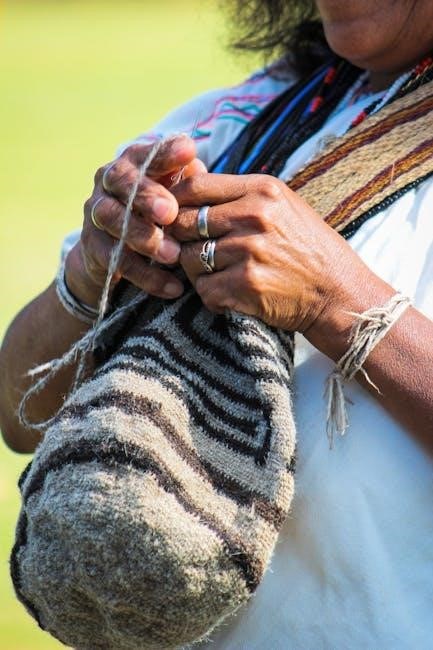
Silicone Yarn Rings
Silicone yarn rings are flexible and soft, offering a comfortable grip for crafters. They are ideal for those with hand or finger challenges, as they provide a gentle yet secure hold. These rings are easy to clean and work well with various yarn types, making them a practical choice for both knitting and crocheting projects.
How to Use a Yarn Ring
Place the yarn ring on the finger guiding the yarn to maintain consistent tension; This simple tool keeps the yarn from slipping, ensuring smooth knitting or crocheting.
Step-by-Step Guide to Placing the Yarn Ring
Start by sliding the yarn ring onto the finger you use to guide the yarn. Ensure it fits snugly but not too tight. Thread the yarn through the ring, holding it gently to maintain even tension. Adjust the ring’s position if needed for comfort. This setup helps prevent yarn from tangling and slipping, making your knitting or crocheting process smoother and more controlled.
Adjusting the Yarn Ring for Comfort and Tension
Place the yarn ring on your index finger, ensuring a snug fit without constriction. Thread the yarn through the ring, adjusting its position for optimal tension. Move the ring up or down your finger to achieve comfort and control; Consider the ring’s material and size, and adjust according to the yarn type. Practice may be needed to balance comfort and tension effectively.
Benefits of Using a Yarn Ring
Yarn rings offer multiple benefits, including preventing tangling, maintaining consistent tension, and enhancing comfort for crafters with hand or finger challenges, making them a must-have tool.
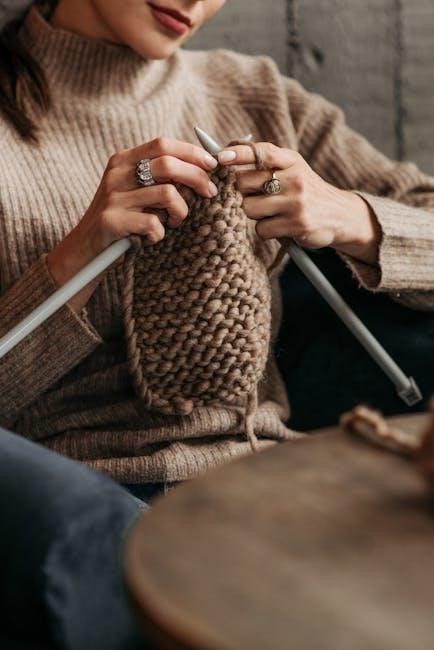
Improved Yarn Tension Control
Yarn rings enable precise control over yarn tension, preventing it from slipping or twisting. By placing the ring on the finger guiding the yarn, crafters can maintain consistent flow, ensuring even stitches and reducing the risk of uneven tension. This tool is especially helpful for beginners or those with hand challenges, promoting smoother and more predictable yarn management throughout projects.
Reduced Yarn Tangling and Knotting
Yarn rings minimize yarn tangling by keeping it organized and untwisted. The ring prevents the yarn from looping or twisting excessively, reducing knots and snags. This ensures a smooth flow of yarn, allowing crafters to focus on their stitches without interruptions. It’s particularly beneficial for working with finer or slippery yarns that tend to tangle easily during projects.
Enhanced Comfort for Crafters with Hand or Finger Challenges
Yarn rings provide exceptional comfort for crafters with hand or finger challenges by reducing strain and pressure. The ring holds the yarn in place, allowing for a relaxed grip and minimizing the need to tightly hold the yarn. This makes knitting or crocheting more accessible and enjoyable for those with limited dexterity or nerve damage, ensuring a smoother crafting experience.
Choosing the Right Yarn Ring
Consider yarn weight, material, and size for optimal comfort and functionality. Select a ring that fits snugly on your finger without restricting movement or causing discomfort.
Factors to Consider: Yarn Weight, Material, and Size
When selecting a yarn ring, consider your yarn’s weight, as heavier yarns like worsted weight may require larger rings. The material, such as plastic or silicone, impacts durability and comfort. Size is crucial for a secure fit without restricting finger movement, ensuring proper yarn tension and ease of use during knitting or crocheting projects.
How to Select the Best Yarn Ring for Your Project
Assess your yarn’s weight, the project’s complexity, and your personal comfort needs. Consider the ring’s material, such as plastic, metal, or silicone, and ensure it fits snugly on your finger. For intricate patterns, opt for adjustable rings to maintain consistent tension. Experiment with different sizes and styles to find the one that enhances your crafting experience and reduces yarn tangling.
Common Mistakes to Avoid
Overtightening the yarn ring can restrict yarn flow and cause discomfort.
Using the wrong size may lead to poor tension control.
Forgetting to adjust the ring can result in uneven stitches.
Overtightening the Yarn Ring
Overtightening the yarn ring can cause discomfort and restrict yarn flow, leading to uneven tension. This may result in stiff stitches or difficulty in moving the yarn smoothly. It’s essential to adjust the ring snugly but not too tightly to maintain control without hindering the crafting process.
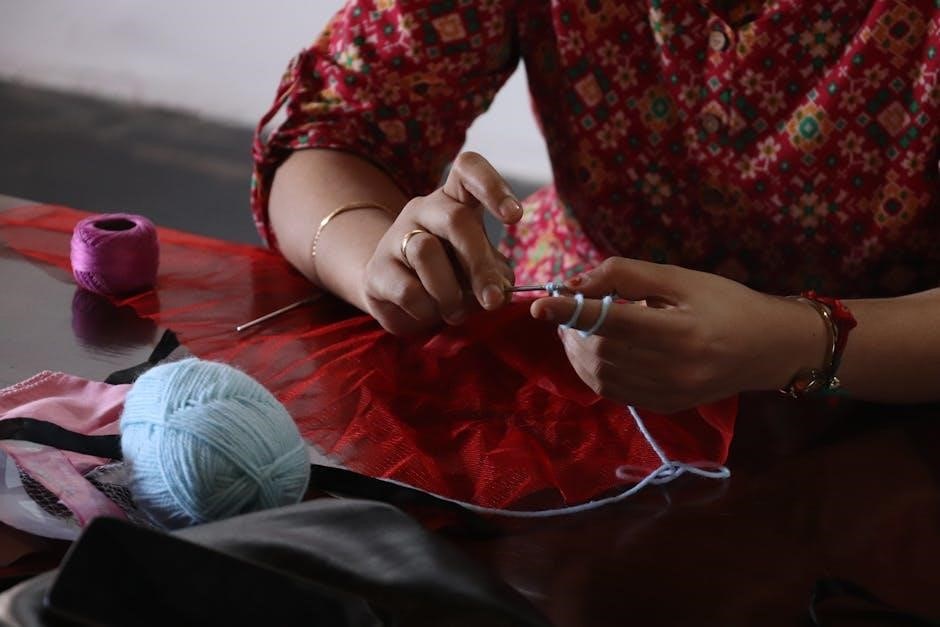
Using the Wrong Size Yarn Ring
Using a yarn ring that is too small or too large can negatively impact your crafting experience. A ring that is too tight may restrict yarn flow, while one that is too loose may not provide adequate control. Selecting the correct size ensures proper tension and comfort, allowing for smooth and efficient knitting or crocheting;

Tips for Troubleshooting Yarn Ring Issues
Adjust the ring’s placement to ensure proper yarn flow and tension. If issues persist, try combining it with other yarn management tools for better control and ease.
Adjusting the Yarn Ring Placement
Adjusting the yarn ring placement is crucial for maintaining proper yarn tension and comfort. Place the ring on the finger guiding the yarn, ensuring it’s snug but not too tight. Experiment with moving it closer to the fingertip for better control or higher up for comfort. This simple adjustment can significantly improve your knitting or crocheting experience.
Combining Yarn Rings with Other Yarn Management Tools
Combining yarn rings with other tools, such as yarn clips, stitch markers, or yarn bowls, enhances yarn management. For example, using a yarn ring with a yarn clip can secure ends, while pairing it with stitch markers helps track patterns. This multitool approach ensures better organization, reduces tangling, and streamlines your knitting or crocheting process for optimal efficiency and creativity.

Best Yarns to Use with Yarn Rings
Choose yarns that suit your project needs. Worsted weight yarn is ideal for beginners, while fingering weight yarn excels in intricate patterns and detailed designs.
Worsted Weight Yarn for Beginners
Worsted weight yarn is a popular choice for beginners due to its medium thickness and smooth texture. It knits up quickly, making it ideal for learning basic stitches and techniques. The yarn is durable and works well with larger needles or hooks, ensuring clear stitch definition. It’s perfect for projects like scarves, hats, and blankets, providing a great tactile experience for new crafters.
Fingering Weight Yarn for Detailed Projects
Fingering weight yarn is lightweight and versatile, perfect for detailed knitting or crochet projects. It’s ideal for intricate patterns, lace shawls, or fine textures. This yarn is soft, durable, and works well with smaller hooks or needles. Using a yarn ring with fingering weight yarn helps maintain even tension and prevents tangling, ensuring smooth progress for delicate designs.

Care and Maintenance of Yarn Rings
To maintain your yarn rings, gently clean them with mild soap and warm water. Avoid harsh chemicals and abrasive materials to prevent damage. Air dry thoroughly before use.
Store yarn rings in a protective case or pouch to prevent scratches. Regular cleaning and proper storage extend their lifespan, ensuring optimal performance for your knitting or crochet projects.
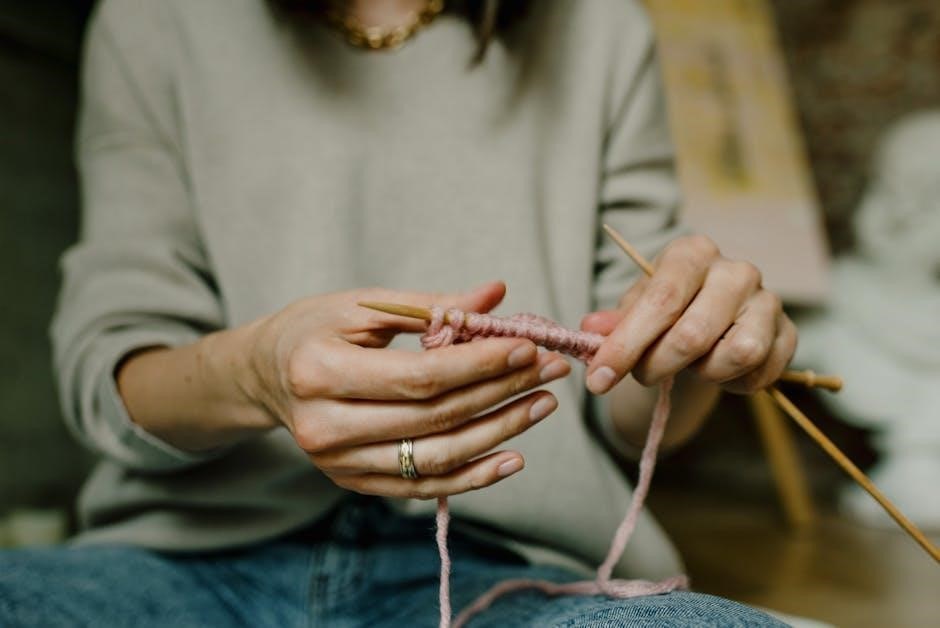
How to Clean and Store Yarn Rings
Clean yarn rings with mild soap and warm water, using a soft-bristle toothbrush to remove yarn fibers. Rinse thoroughly and air dry. Store in a protective case or pouch to prevent scratches and damage. Keep them in a dry, cool place away from direct sunlight and extreme temperatures to maintain their shape and functionality over time.
Extending the Lifespan of Your Yarn Ring
Regularly clean your yarn ring with mild soap and water to remove yarn residue. Avoid exposure to harsh chemicals or extreme temperatures. Store in a protective case to prevent scratches. Handle gently to prevent bending or warping, especially for metal or plastic rings. Proper care ensures durability and maintains smooth yarn flow for years of reliable use.
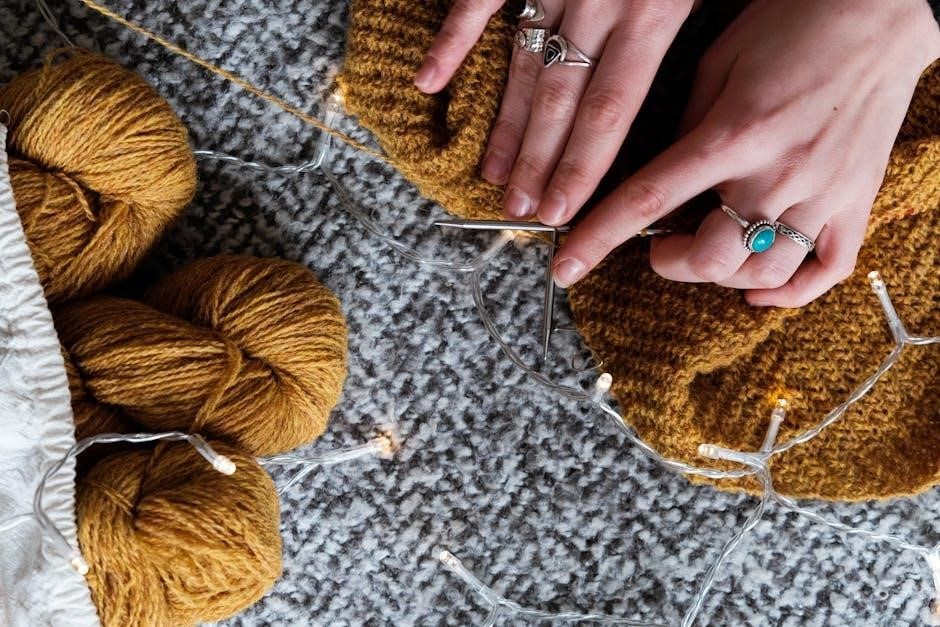
Advanced Techniques with Yarn Rings
Explore advanced methods like using yarn rings for intricate cabling or lace patterns. Combine rings with circular needles for seamless projects, enhancing stitch consistency and design versatility.
Using Yarn Rings for Cabling or Lace Knitting
Yarn rings are invaluable for cabling and lace knitting, as they keep the yarn from twisting and tangling during complex stitch patterns. By maintaining consistent tension, rings help crafters achieve precise stitches, especially in intricate designs. This tool is particularly beneficial for patterns requiring multiple yarn strands or frequent stitch changes, reducing tangles and knots for a smoother workflow.
Combining Yarn Rings with Circular or Double-Pointed Needles
Combining yarn rings with circular or double-pointed needles enhances project management, especially for sleeves, hats, or intricate patterns. The yarn ring prevents the yarn from tangling or slipping between needles, ensuring smooth stitching. This method is particularly useful for projects requiring frequent needle changes, maintaining consistent tension and reducing yarn flow disruptions for a seamless crafting experience.
Yarn rings are essential for improving yarn tension and reducing tangling, offering versatility for various knitting or crochet projects. Try them for better control and reduced frustration in your crafting journey.
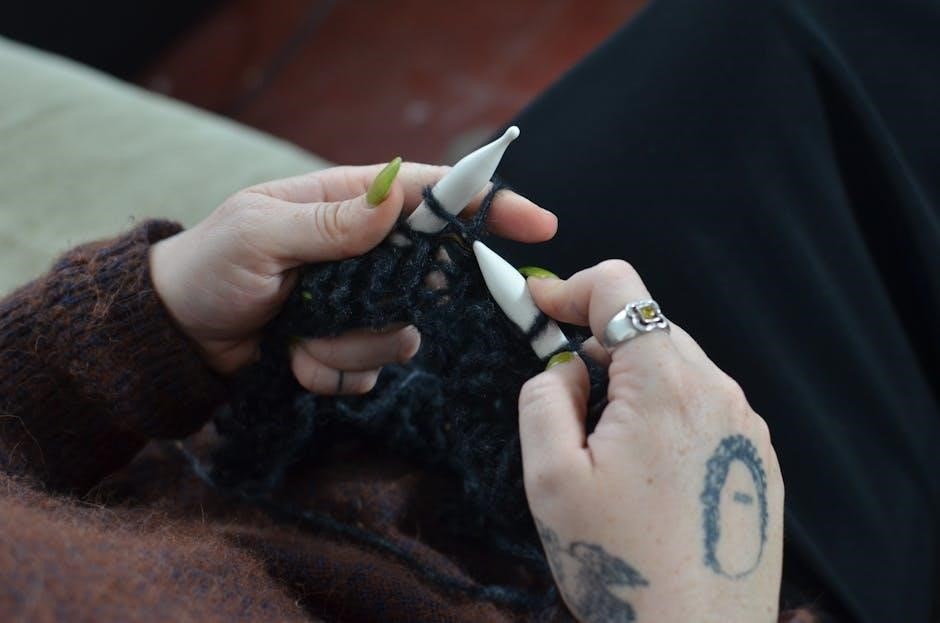
Final Thoughts on the Importance of Yarn Rings
Yarn rings are simple, cost-effective tools that enhance knitting and crocheting by managing yarn flow and preventing tangles. They are especially helpful for crafters with hand challenges, offering better control and comfort. Investing in a yarn ring can elevate your crafting experience, making projects smoother and more enjoyable. Try one today to see the difference it makes.
Encouragement to Try Yarn Rings for Smoother Crafting
Don’t hesitate to explore the benefits of yarn rings. They are inexpensive, easy to use, and make crafting more enjoyable. Whether you’re a beginner or an experienced crafter, yarn rings can enhance your projects by maintaining consistent tension and reducing yarn tangling. Give them a try and discover how they can streamline your knitting or crocheting process for better results.